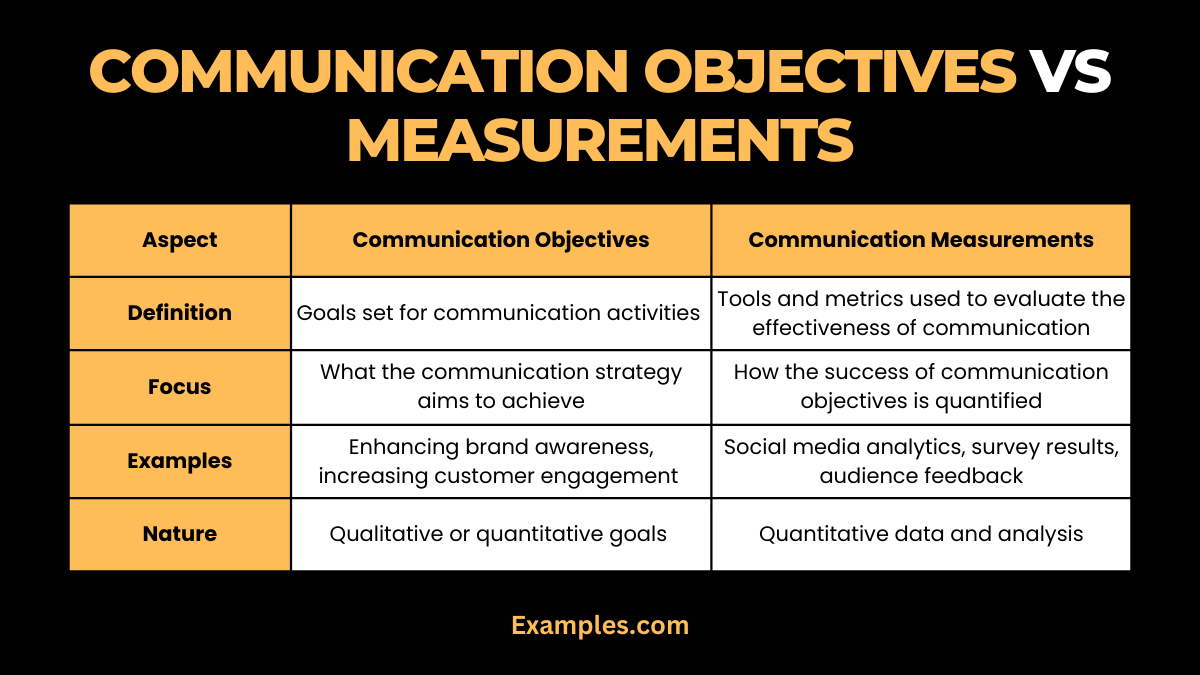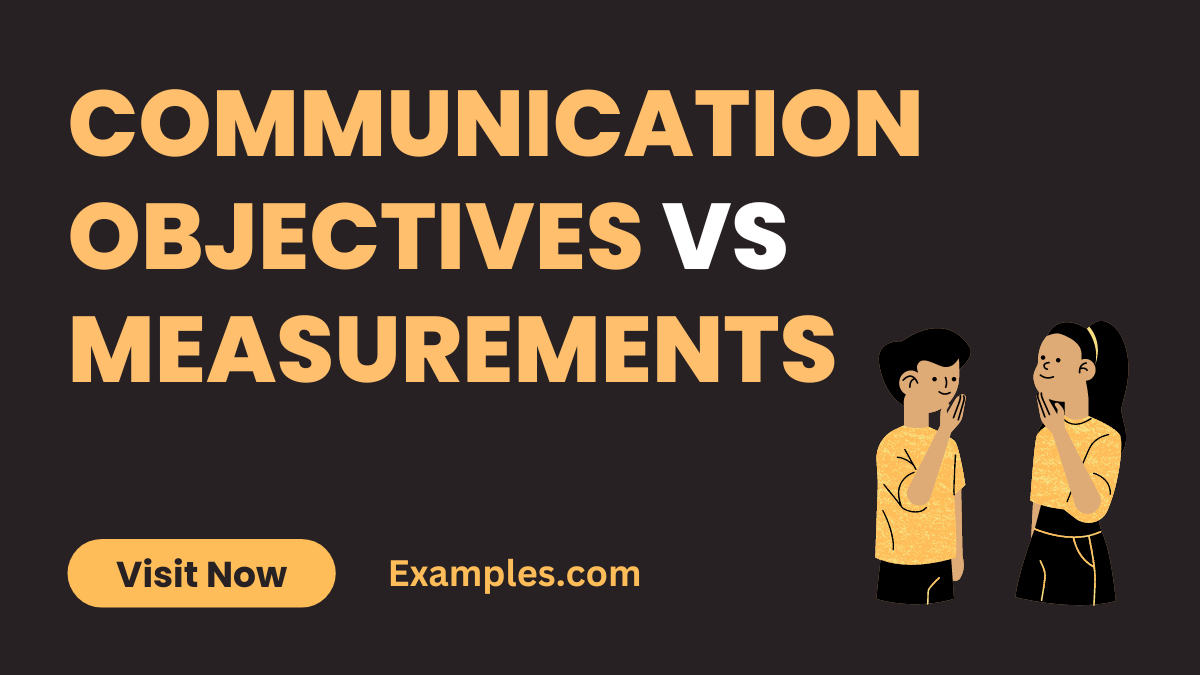Communication Objectives vs Measurements
Delve into the intricate world of communication examples with our detailed guide on Communication Objectives vs Measurements. This comprehensive overview offers valuable insights and practical examples, shedding light on how to effectively set, track, and measure communication objectives. Whether you’re a seasoned professional or just starting, this guide is an essential resource for anyone looking to enhance their communication strategy.
Download Communication Objectives PDF
Download Communication Measurements PDF
Difference Between Communication Objectives and Measurements

The difference between communication objectives and measurements lies in their purpose and application. Communication objectives are the goals set for a communication strategy, such as increasing brand awareness or improving stakeholder engagement. We explore a range of Types of Communication Objectives, including Awareness Building Communication Objective, Information Dissemination Communication Objective, and Persuasion Communication Objective. In contrast, communication measurements are the tools and metrics used to assess the effectiveness and impact of these objectives. They provide data to evaluate whether the set goals are being met.
| Aspect | Communication Objectives | Communication Measurements |
|---|---|---|
| Definition | Goals set for communication activities | Tools and metrics used to evaluate the effectiveness of communication |
| Focus | What the communication strategy aims to achieve | How the success of communication objectives is quantified |
| Examples | Enhancing brand awareness, increasing customer engagement | Social media analytics, survey results, audience feedback |
| Nature | Qualitative or quantitative goals | Quantitative data and analysis |
| Role | Guide the direction of communication efforts | Provide feedback and insights on the effectiveness of communication strategies |
In this table, the difference between Communication Objectives and their corresponding measurements is clearly outlined. While objectives define what you aim to achieve with your communication efforts, measurements give you the tools to assess how well these objectives are being met. Understanding this distinction is crucial for any effective communication plan.These objectives are instrumental in scenarios like Communication Objectives in Marketing, enhancing Brand Reinforcement Communication Objective, or focusing on Relationship Building Communication Objective within an organization.
10 Communication Objectives Examples

Explore our curated list of 10 Communication Objectives Examples, essential for any effective communication strategy. From enhancing team dynamics to boosting brand presence, such as those developing Communication Objectives for Therapy, Communication Objectives for Treatment Plans, or even Communication Objectives in Education, understanding the Importance of Communication Objectives is crucial.these objectives are vital in shaping successful interactions in various contexts. Each example comes with a brief explanation and illustrative sentences, providing a practical understanding of how to implement these objectives.
- Enhance Internal Team Communication: Aim to improve the clarity and frequency of communication within a team.
Example: Scheduling weekly team meetings to discuss progress and address any concerns. - Increase Brand Awareness: Focus on strategies to make your brand more recognizable.
Example: Utilizing social media campaigns to highlight brand values and offerings. - Improve Customer Service Interaction: Enhance the quality of interactions with customers.
Example: Training customer service representatives to effectively address and resolve customer issues. - Strengthen Stakeholder Relationships: Build and maintain strong relationships with key stakeholders.
Example: Regular updates and meetings with stakeholders to keep them informed and involved. - Drive Employee Engagement: Encourage active participation and involvement of employees.
Example: Implementing an internal platform for employees to share ideas and feedback. - Boost Social Media Engagement: Increase interaction with your audience on social media platforms.
Example: Creating engaging content and responding promptly to comments and messages. - Promote Product Knowledge Among Sales Team: Ensure the sales team is well-informed about products.
Example: Regular training sessions on product features and benefits. - Facilitate Effective Crisis Communication: Develop a plan to communicate effectively during crises.
Example: Preparing a crisis communication protocol with clear steps and spokespersons. - Enhance Public Speaking Skills: Improve the ability to communicate effectively in public speaking scenarios.
Example: Offering workshops and training sessions on public speaking and presentation skills. - Cultivate Media Relations: Develop and maintain positive relationships with media outlets.
Example: Regular press releases and media briefings to share company news and updates.
10 Communication Measurements Examples
Dive into our comprehensive list of 10 Communication Measurements Examples, each illustrating a key aspect of evaluating communication effectiveness. The guide also delves into Smart Communication Objectives, offering insights on Communication Training Objectives and Management Communication Objectives, essential for developing a Strategic Communication Objective.From analyzing social media metrics to surveying customer satisfaction, these measurements offer invaluable insights into the success of communication strategies. Each example is accompanied by explanations and sentences, showcasing practical applications.
- Social Media Engagement Rate: Measure interactions like likes, shares, and comments on social media.
Example: Tracking the number of comments and shares per post to gauge audience interest. - Customer Satisfaction Surveys: Use surveys to gather feedback from customers.
Example: Conducting monthly surveys to assess customer satisfaction with service and products. - Employee Feedback Forms: Collect feedback from employees about internal communication.
Example: Quarterly feedback forms to understand employee perspectives on internal communication effectiveness. - Brand Mention Analytics: Track how often your brand is mentioned online.
Example: Using analytics tools to monitor frequency and sentiment of brand mentions. - Email Open and Click Rates: Analyze how many people open and engage with your emails.
Example: Reviewing email campaign statistics to adjust content for higher engagement. - Website Traffic Analytics: Monitor the number of visitors and their behavior on your website.
Example: Using web analytics to track visitor engagement and time spent on key pages. - Sales Conversion Rates: Assess the effectiveness of communication in driving sales.
Example: Comparing sales data before and after a major marketing campaign. - Media Coverage Quality and Quantity: Evaluate the presence and portrayal of your brand in the media.
Example: Assessing the tone and frequency of media coverage following press releases. - Internal Audit of Communication Processes: Regularly review internal communication methods.
Example: Conducting an annual audit to identify areas of improvement in internal communication. - Training Effectiveness Evaluation: Determine the impact of communication training programs.
Example: Post-training assessments to evaluate improvements in team communication skills.
Communication Measurement Tools
Understanding the relationship between communication objectives and measurements is crucial in integrated marketing communication. Here are 10 key points with descriptions to guide you:
- Define Clear Objectives: Establish specific communication goals like increasing brand visibility or customer engagement.
- Identify Relevant Metrics: Choose metrics that directly relate to your objectives, such as social media engagement for brand visibility.
- Use Quantitative Measurements: Employ numerical data like survey scores or sales figures to measure success.
- Incorporate Qualitative Assessments: Consider feedback and reviews for a more nuanced understanding of communication effectiveness.
- Regular Monitoring: Consistently track progress against objectives to identify trends and areas for improvement.
- Benchmarking: Compare performance against industry standards or competitors to gauge relative success.
- Adaptability: Be willing to adjust objectives and strategies based on measurement outcomes.
- Integrate Across Channels: Ensure measurements cover all communication channels for a holistic view.
- Employee Feedback: Use internal feedback to measure the effectiveness of internal communication.
- Customer Journey Analysis: Track how communication impacts customer behavior at different stages.
How to Measure Communication Skills Among Students
Measuring communication skills among students involves evaluating both verbal and non-verbal abilities. This process can include observing students in group discussions, assessing oral presentations for clarity and coherence, and analyzing written assignments. Moreover, the guide covers the distinction between Communication Goals vs Objectives and the comparative analysis of Communication Objectives vs Measurements and Communication Objectives vs Marketing Objectives. These methods help educators understand students’ proficiency in expressing ideas, listening, and engaging effectively with peers.
- Observation in Group Activities: Monitor how students interact in group settings.
- Oral Presentations: Evaluate clarity, coherence, and confidence in student presentations.
- Peer Reviews: Use peer feedback to assess communication effectiveness.
- Role-playing Exercises: Simulate real-life scenarios to test practical communication skills.
- Standardized Testing: Incorporate tests that evaluate verbal and non-verbal communication.
- Class Participation: Note regularity and quality of contributions in class discussions.
- Written Assignments: Analyze clarity, structure, and style in written communication.
- Surveys and Questionnaires: Gather self and peer assessments on communication abilities.
How to Measure Effective Communication in the Workplace
To measure effective communication in the workplace, one can utilize a combination of quantitative and qualitative methods. Employee surveys, performance reviews, and 360-degree feedback provide insights into how communication affects workplace dynamics. Analyzing email response rates, meeting outcomes, and conflict resolution effectiveness also offer valuable data. These measurements help in understanding the impact of communication on productivity, employee engagement, and overall organizational health.
- Employee Surveys: Gather feedback on internal communication effectiveness.
- Performance Metrics: Link communication efforts with performance indicators like productivity.
- 360-Degree Feedback: Collect comprehensive feedback from various levels within the organization.
- Meeting Effectiveness: Assess the outcomes and efficiency of team meetings.
- Conflict Resolution Rates: Monitor how effectively communication resolves workplace conflicts.
- Internal Audit: Regularly review and assess internal communication channels and practices.
- Email Analytics: Analyze open and response rates of internal emails.
- Exit Interviews: Use feedback from departing employees to assess communication climate.
How to Make Your Communication Objectives Measurable
Making communication objectives measurable involves applying the SMART criteria – ensuring they are Specific, Measurable, Achievable, Relevant, and Time-bound. Set clear, quantifiable targets aligned with broader business goals and measuring communication objectives. Use data-driven approaches like analytics tools for tracking progress and incorporate feedback mechanisms for continuous improvement. Regularly review and adjust strategies based on measurable outcomes to ensure communication objectives are effectively guiding your strategy and yielding desired results.
- Set Specific Targets: Define clear, quantifiable goals like ‘increase website traffic by 20%’.
- Align with Business Goals: Ensure communication objectives support overall business objectives.
- Use SMART Criteria: Make objectives Specific, Measurable, Achievable, Relevant, and Time-bound.
- Regular Progress Review: Establish periodic check-ins to assess progress towards objectives.
- Feedback Mechanisms: Implement systems to gather ongoing feedback related to objectives.
- Data-Driven Approach: Utilize data analytics tools to measure and analyze communication efforts.
- Adjust Strategies Based on Data: Be flexible to change strategies based on measurement outcomes.
- Document and Report: Keep detailed records and reports of progress for accountability.
This guide provides a comprehensive understanding of Communication Objectives vs Measurements, offering practical strategies for measuring communication skills among students, in the workplace, and making communication objectives measurable. These insights are vital for anyone looking to enhance their communication strategy and ensure its effectiveness.Whether it’s for a Communication Campaign Objective, Communication Objectives for Resume, or Communication to Stakeholders Objective, this guide provides an all-encompassing view, making it an invaluable resource for anyone looking to refine their communication approach.



